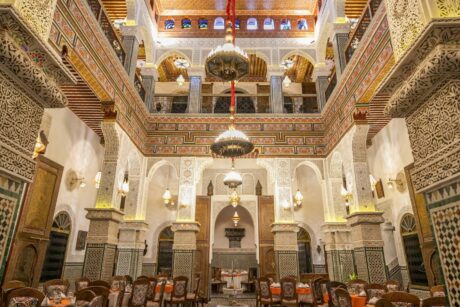Nestled within the ancient walls of Fes el-Bali, the historic medina of Fes, Morocco, lies one of its most iconic landmarks—the Bab Bou Jeloud, also known as the Blue Gate. This magnificent gateway stands as a testament to the city’s rich cultural heritage and enduring legacy as a center of trade, scholarship, and Islamic civilization.
Built in the early 20th century by the French colonial administration, Bab Bou Jeloud serves as the main entrance to the bustling medina, welcoming visitors from around the world into its vibrant streets and alleys. Its distinctive blue and green ceramic tiles, intricately carved woodwork, and towering horseshoe arches make it a sight to behold and a symbol of Fes’ unique blend of Arab, Berber, and Andalusian influences.
As you approach Bab Bou Jeloud, you’re immediately struck by the beauty and grandeur of its design. The azure blue tiles that adorn its facade shimmer in the sunlight, while the intricate patterns and geometric motifs evoke a sense of timeless elegance and sophistication.
Stepping through the gate, you enter a world of sensory delights—a kaleidoscope of sights, sounds, and smells that envelops you in the vibrant tapestry of Moroccan culture. The bustling streets are alive with the hustle and bustle of daily life, as merchants hawk their wares in colorful souks, craftsmen ply their trade in tiny workshops, and locals go about their daily routines.
But amidst the chaos of the medina, there is a sense of serenity and tranquility within the walls of Bab Bou Jeloud. Here, the pace of life slows down, and visitors are invited to wander at their leisure, soaking in the sights and sounds of this ancient city and immersing themselves in its rich history and culture.
For centuries, Bab Bou Jeloud has stood as a symbol of Fes’ enduring resilience and cultural vibrancy. It has witnessed the rise and fall of empires, the ebb and flow of trade routes, and the convergence of peoples and cultures from across the Muslim world. Today, it continues to stand as a proud testament to Fes’ rich cultural heritage and its unwavering commitment to preserving its traditions for future generations to enjoy.









